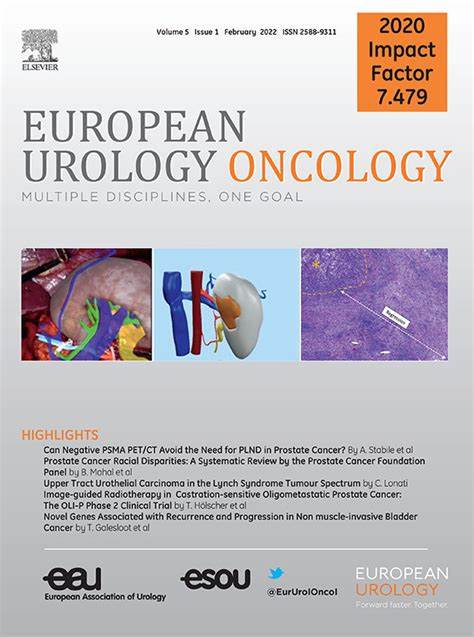Incidental Prostate Cancer in Patients Undergoing Surgery for Benign Prostatic Hyperplasia: A Predictive Model
IF 8.3
1区 医学
Q1 ONCOLOGY
引用次数: 0
Abstract
Background and objective
Histopathological examination of surgical specimens for benign prostatic hyperplasia (BPH) can detect incidental prostate cancer (iPCa). The aim of our study was to develop a predictive model for iPCa diagnosis for patients for whom BPH surgery is being considered.
Methods
We conducted a retrospective analysis of medical files for patients who underwent BPH surgery in three academic centers between 2012 and 2022. Patients diagnosed with PCa before surgery were excluded. We calculated the global iPCa rate, and the clinically significant iPCa rate (grade group ≥2). Univariate and multivariable regression models were used to assess factors predictive of iPCa. The area under the receiver operating characteristic curve (AUC) was compared for each risk factor and for the global model. We used χ2 automated interaction detection (CHAID) for decision tree analysis.
Key findings and limitations
We included 2452 patients in the analysis, of whom 247 (10.0%) had iPCa, which was clinically significant in 49/247 cases (20.2%). Multivariable analysis revealed that age and prostate-specific antigen density (PSAD) were independent predictive factors for iPCa diagnosis. The AUC for a model including age and PSAD was 0.65. CHAID analysis revealed that patients with PSAD >0.1 ng/ml/cm3 had an iPCa risk of 23.4% (χ2 = 52.6; p < 0.001). For those patients, age >72 yr increased the iPCa risk to 35.4% (χ2 = 11.1, p = 0.008). Our study is mainly limited by its retrospective design.
Conclusions and clinical implications
Age and PSAD were independent risk factors for iPCa diagnosis. The combination of age >72 yr and PSAD >0.1 ng/ml/cm3 was associated with an iPCa rate of 35.4%.
Patient summary
We performed a study to find predictors of prostate cancer for patients undergoing surgery for benign enlargement of the prostate. Our model can identify patients at risk, and diagnose their cancer before surgery. This could avoid unnecessary or harmful procedures.
接受良性前列腺增生手术患者的偶发前列腺癌:一种预测模型。
背景和目的:良性前列腺增生症(BPH)手术标本的组织病理学检查可发现偶发前列腺癌(iPCa)。我们的研究旨在为考虑接受良性前列腺增生手术的患者建立一个 iPCa 诊断预测模型:我们对 2012 年至 2022 年期间在三个学术中心接受良性前列腺增生手术的患者的医疗档案进行了回顾性分析。排除了手术前诊断为 PCa 的患者。我们计算了总体 iPCa 率和有临床意义的 iPCa 率(等级组≥2)。我们使用单变量和多变量回归模型来评估预测 iPCa 的因素。比较了每个风险因素和整体模型的接收者操作特征曲线下面积(AUC)。我们使用χ2自动交互检测(CHAID)进行决策树分析:我们在分析中纳入了 2452 例患者,其中 247 例(10.0%)患有 iPCa,49/247 例(20.2%)具有临床意义。多变量分析表明,年龄和前列腺特异性抗原密度 (PSAD) 是 iPCa 诊断的独立预测因素。包括年龄和 PSAD 在内的模型的 AUC 为 0.65。CHAID 分析显示,PSAD >0.1 ng/ml/cm3 的患者的 iPCa 风险为 23.4% (χ2 = 52.6; p 72 年后,iPCa 风险增至 35.4% (χ2 = 11.1, p = 0.008)。我们的研究主要受限于其回顾性设计:结论和临床意义:年龄和 PSAD 是 iPCa 诊断的独立风险因素。患者总结:我们进行了一项研究,旨在找出因前列腺良性增生而接受手术的患者的前列腺癌预测因素。我们的模型可以识别高危患者,并在手术前诊断出他们的癌症。这可以避免不必要或有害的手术。
本文章由计算机程序翻译,如有差异,请以英文原文为准。
求助全文
约1分钟内获得全文
求助全文
来源期刊

European urology oncology
Multiple-
CiteScore
15.50
自引率
2.40%
发文量
128
审稿时长
20 days
期刊介绍:
Journal Name: European Urology Oncology
Affiliation: Official Journal of the European Association of Urology
Focus:
First official publication of the EAU fully devoted to the study of genitourinary malignancies
Aims to deliver high-quality research
Content:
Includes original articles, opinion piece editorials, and invited reviews
Covers clinical, basic, and translational research
Publication Frequency: Six times a year in electronic format
 求助内容:
求助内容: 应助结果提醒方式:
应助结果提醒方式:


